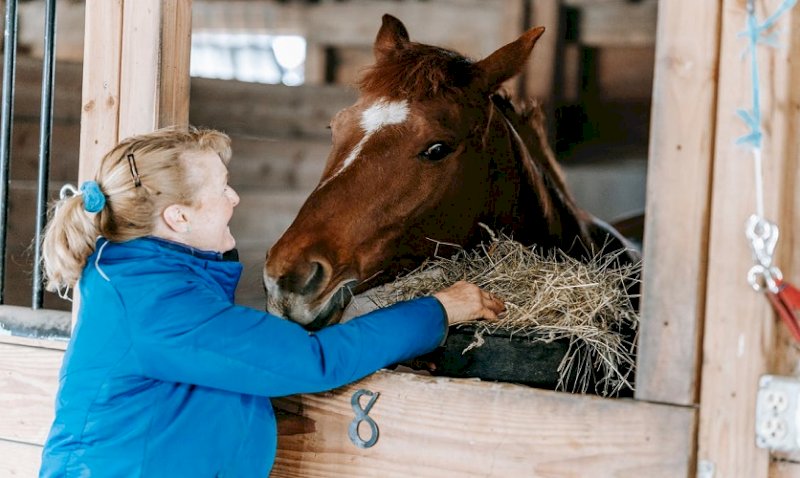What is Oat Hay and How it is Beneficial for Horses?
- Dec 08, 2021
- 11040 views
- Share

“One touch is all it takes… to make a girl fall in love with a horse..!” Such are they!
Does the world consider you as a horse groupie? It's no wonder these adorable species have an innate quality that compels one to admire them.
But just riding or adoring them is not enough. You need to feed your stallion and maintain a good diet for their overall development. They are generally fed with various types of hay and oat hay or oaten is one of the reasonable options with high nutritional value.
Before you decide to pick a roll of oaten for your horse, get the details of this temperate forage in this article. Swipe up to read!
What is Oaten hay?
Oat is a cereal crop and oaten hay is considered as a reasonable fodder option for horses. This is a premium quality full-flavored hay with high fiber content and is a good source of digestible energy depending on the stage of maturity at harvest. Though it has got a nuty and crunchy flavor, it's hard, thick and rough stalks make it quite chewy which is why some horses prefer other hay over oaten.
Despite its rough texture, oaten hay is a superior fodder option for horses as it helps digestive health and promotes enhanced teeth quality. Though these are easily digestible due to its high fiber content, some often reject these due to high starch level.
This is a good source of energy but oaten is often avoided by some horse owners and in some cases the animal itself rejects feeding on it. Want to know why?
Keep reading the sections below to get more details on this!
History of Oaten hay
Oats are best grown in temperate regions and are the wild ancestors of Avena sativa. This is a secondary crop derived from primary cereal domestication.This is one of the multi-purpose crops grown in Australia and New Zealand which is used for milling, forage, hay, haylage, chaff, green manure and others. 1.35 tons of oaten hay was produced in Australia in the year 1998-1999.
Around the late 19th century during the beginning of World War I oat grain and chaff were exported to Australia. Until 1950 oat crops were utilized as animal forage. And, as per statistics, in the year 1981-1982 26,500 ha fodder oats was grown in New Zealand.
Let’s discuss some facts about this plant!
Plant description
- Oats generally grow in temperate regions and have higher tolerance towards rain than any other cereals.
- These are grown during cool spring and fall weather.
- Oat grass hay is grown with alfalfa to improve its protein level.
- The plant grows upto 2 meters and features flat, narrow veined leaves tapered to a fine point.
- The main diseases caused to this plant are stem rust, leaf rust, bacterial bright, powdery mildew, barley yellow dwarf virus, etc.
- It is mainly grown in South Dakota, North Dakota and Wisconsin.
Ideal cutting time
When oat seed is out of the milk stage it is the perfect time to cut the oat hay. This is when you can get a high quality product with a nice hue along with good carbohydrate content and sweetness in the stem.
Oats are one of the most sought-after energy sources for horses that has been in use as livestock fodder for centuries. It's high in energy and is easy to digest, which makes it preferable for most horses. But some reject these forages due to high starch content.
Let’s check out the section below to figure out both its advantages and disadvantages!
Pros
- Oat hay is good for horses who are underweight, growing, sensitive to carbohydrates, have gastric ulcer, breeding, lactating or late in pregnancy.
- Oats are perfect for animals, especially herbivores who need high fiber and low protein.
- Regular consumption of oat hay improves gut health of the horses.
- Oats increase chewing time with gnawing activity which keeps teeth clean.
- Besides high fiber content, oat hay is rich in vital nutrients, vitamins, minerals and other supplements.
- Pure oat is rarely sold, rather it is blended with wheat, barley and other crops to enhance its nutritional value.
- These are not only beneficial for horses but also advantageous for cattle, sheep, goats, camels, rabbits and guinea pigs if included in their regular diet in specific amounts.
Cons
- Firstly, pure oaten hay is pricier and not easily available. Rather, oat blended with other hay is nutritionally beneficial, pocket-friendly and readily available as well.
- Due to its thicker and harder strands some horses refuse to eat oat hay.
- Oats have the ability to store more starch than any other hay. It has 30% more starch and water soluble carbohydrates(WSC), which is collectively known as Non-Structural carbohydrate or NSC. Hence, these for those horses who require a low NSC diet.
- Oat hay is high in fructan levels. But high fructan might cause behavioral changes among horses, excessive gassiness and mild colic as well.
Nutrient level:
- Crude Protein - 7%
- Crude fat - 1.50%
- Crude fiber - 32%
- Moisture - 15%
Conclusion
Various types of hay are available with their individual nutrition qualities. Oat hay is equally great if feeded to the young horses or to the livestock animals. The nutrient value gets even enhanced if cut at the right time.
So that's all about oat hay or oaten. If you find it useful and if it seems great for your horses then go for it. We at Farmtender have listed some of the good quality oat hay rolls that would make your search for oaten hay for sale way more seamless.
Check out Farmtender for more or directly get in touch with us for any queries!










Share Ag articles Via